Sapling editor and self-confessed nature nerd, Linda Jane Keegan, reviews an amazing selection of books about the world around us. Look up close at tiny creatures from land to sea, to far, far away into the night sky. These would make for some perfect end of year gifts!
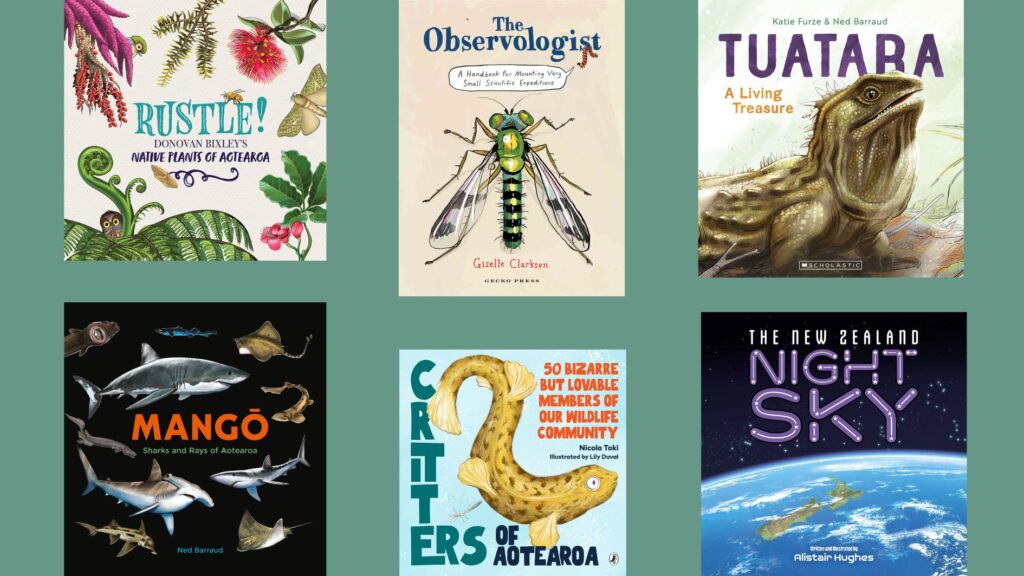
The Observologist: A Handbook for Mounting Very Small Scientific Expeditions, by Giselle Clarkson (Gecko Press)
The Observologist is everything I ever wanted out of a handbook of small scientific expeditions, and in fact I was already gushing over it the moment I knew of its existence. Giselle received (yet another) fangirling email from me in anticipation of how excited I was that she was making this super cool book. It’s the kind of thing I would have pored over as a child (though I definitely would have taken it Very Seriously and gone round calling myself an Observologist and quoted the jokes as Real Facts). And when I finally had it in my hot little hands, I was not disappointed.
Everything about this book is wonderful; the production (a hardback with spot gloss on the cover illustrations), the writing tone, the illustrations, even the paper stock (look, I love a sturdy paper stock okay—what is that, 200gsm? Imagine the heart eyes emoji face).
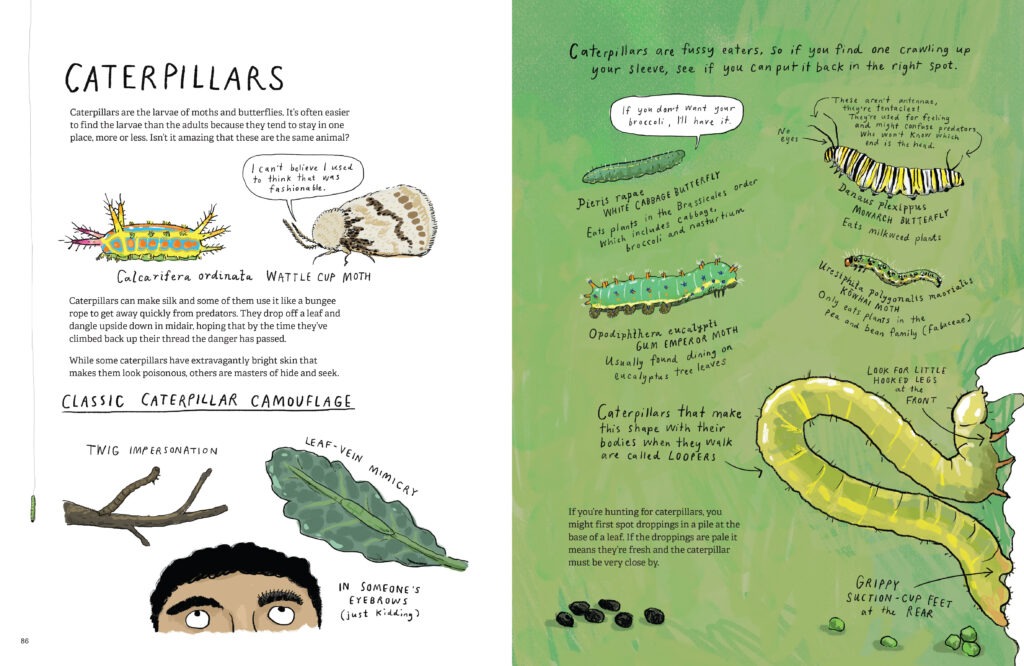
Giselle has exquisitely merged science and whimsy with her characteristic cartoon style accompanying richly detailed text. The writing is like a delicious snack; so sweet and palatable and easy to digest. Handwritten headings and labels add pleasing variety to the text and work in harmony with the illustrations. The whole book is a delightful piece of writing, illustration, science, and design—a carefully curated museum for all ages.
Although not a specifically New Zealand book—there are many examples of overseas biota—there are plenty of local examples, and the tone is very Kiwi (except for the Americanised spelling). It’s great for both the armchair and field observer, and can dipped in and out of, or read cover to cover. It inspires the reader to take notice of the smallest things, in places that anyone can look—a damp corner, pavement, a weedy patch, behind the curtains.
The book closes with “An Observologist’s Final Exam” in which any answer can be correct, and the following page is a certificate awarding the qualification of Observologist, bestowing upon the recipient “the authority to perform observology here, there and everywhere.” But if I’ve learnt anything from this book, it’s that the only authority we need to observe the world around us is our own.
The Observologist is the first book that Giselle has both written and illustrated, and I can’t wait to see what she does next.
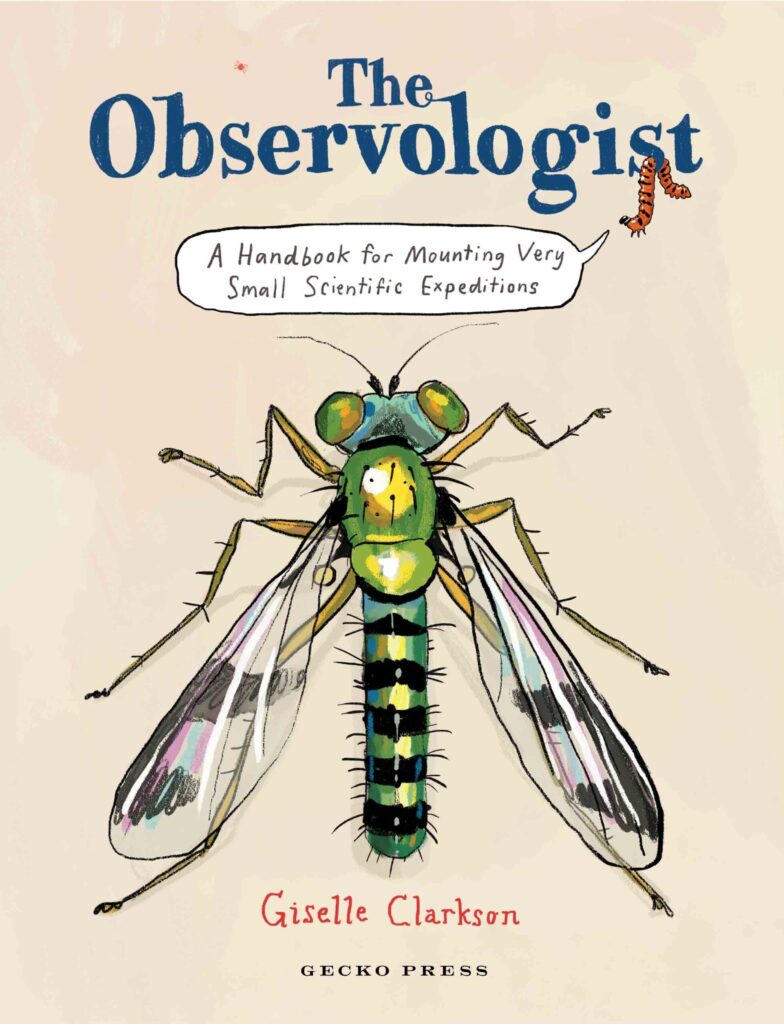
Critters of Aotearoa: 50 Bizarre But Lovable Members of Our Wildlife Community, by Nicola Toki & Lily Duval (Puffin)
Critters of Aotearoa is a delightful dive into 50 bizarre but lovable creatures of Aotearoa, originally featured on RNZ’s Critter of the Week programme with Jesse Mulligan and Nicola Toki. Although not strictly all ‘creatures’ (there are fungi and plants, among others), the critters in this book are all charming or ugly or both.
As a long-time fan of the radio segment, I was excited to see that it had been turned into a book. Each spread features a critter, information about it, and its attractiveness rating (the ‘critter attractiveness-ometer’). The writing is engaging and digestible, and filled with fascinating facts and easy to visualise descriptions such as lamprey using their jaws to climb up waterfalls “almost like a reverse slinky.” Most words that might be tricky for younger readers are defined, although not all, and some language and references that adults will enjoy might be lost on younger readers (“East Coast wave”, Dwayne ‘The Rock’ Johnson, Arabian Nights).
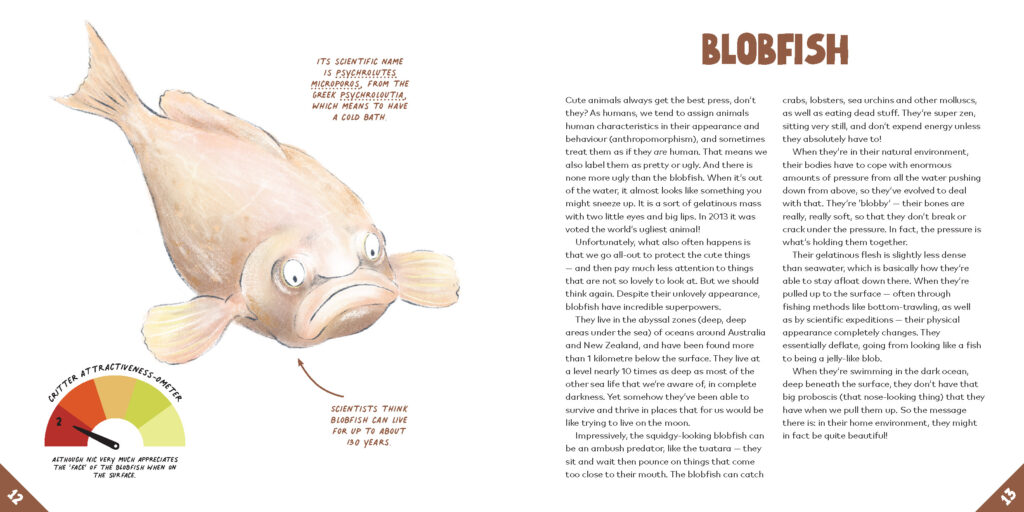
Tucked into all the facts are fun tidbits, such as an eel that ate a radio transmitter-sporting wētā, resulting in some unusual data; and that female horrid stick insects (their name really is ‘horrid’!) can reproduce by making clones of themselves! There is a lot of information packed in about each species, with a good balance of scientific description and conversational quips. Although it bothers me that not all species have their scientific name noted in the text.
Lily Duval’s illustrations accurately depict the critters, except for a little whimsy in their cartoon eyes. This style choice absolutely works in this context, and probably makes some of the less attractive creatures a bit more cute looking! Handwritten-style text accompanies the illustrations with bite-sized chunks of additional information.
This is a book that can be enjoyed by a range of ages while learning more about some of Aotearoa’s stranger wildlife.
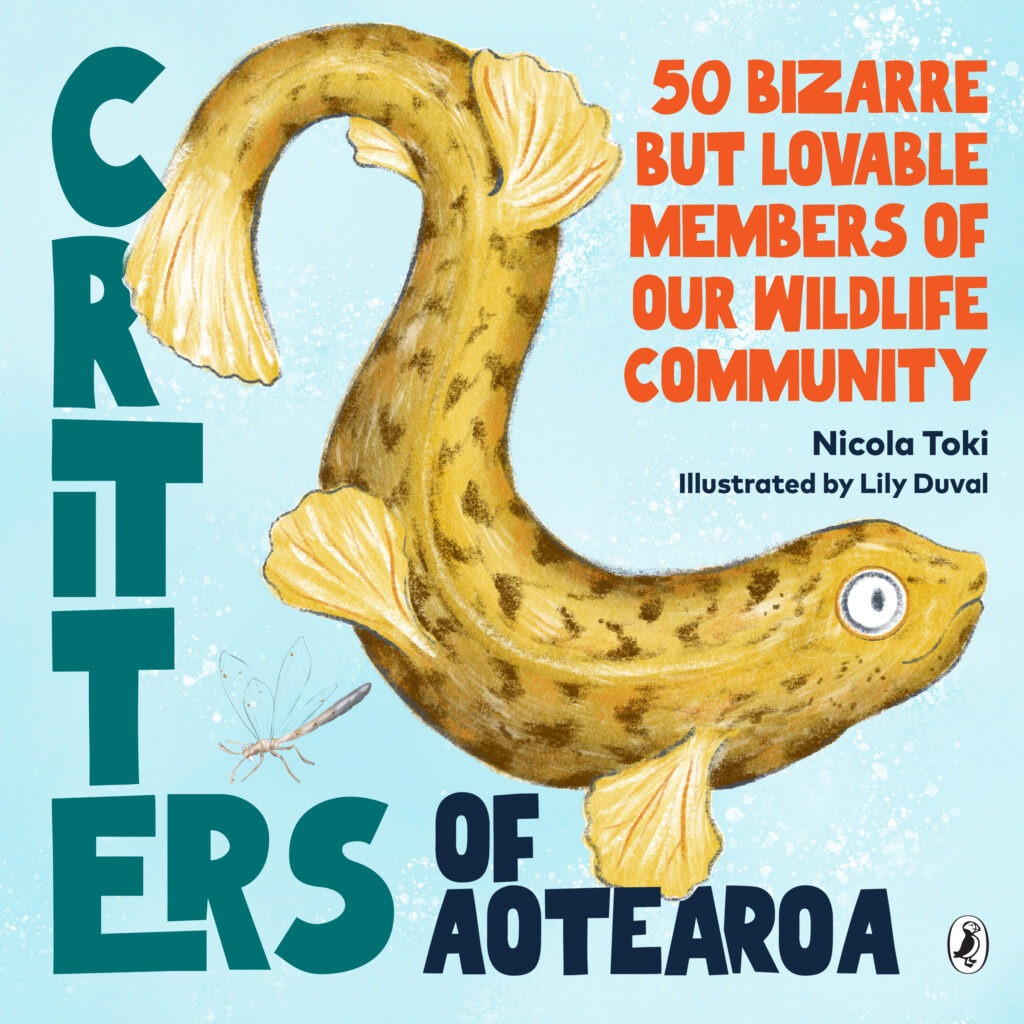
Critters of Aotearoa
Written by Nicola Toki
Illustrated by Lily Duval
Published by Penguin Random House
RRP: $30.00
Mangō: Sharks and Rays of Aotearoa, by Ned Barraud (Te Papa Press)
Another wonderfully illustrated nature book from Ned Barraud, Mangō is a great introduction to New Zealand’s sharks and rays for the beginner or more sealife-enthused reader.
The book opens with a narrative around the hatching of a carpet shark, before launching into sections covering various areas such as sharks in pre-history, shark senses, species of sharks, and human interactions. The layout of the text and illustrations makes it easy to follow and each paragraph is not too much to read at once. Scientific terminology is explained—I really liked the level of detail—such as the lateral line, and ampullae of Lorenzini (aka my trypophobic nightmare).
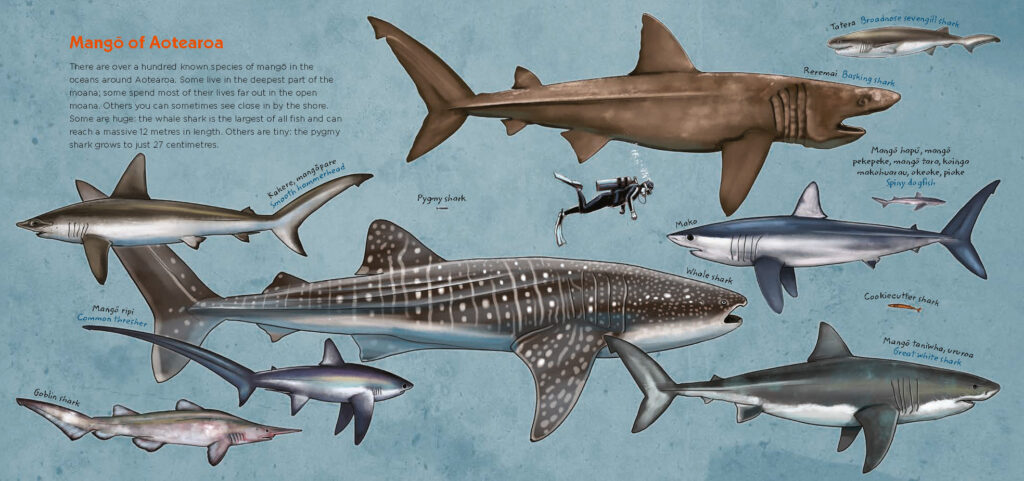
The species in the book are labelled throughout in an appealing handwritten style, with Māori names included. I appreciated the inclusion of a section about mangō and te ao Māori, but I’m not sure if the use of terms ‘mythical’ and ‘legends’ describing some of the pūrākau captures the nuance of mātauranga Māori as science.
The illustrations are fabulous and detailed—just what we’ve come to expect from Ned—and my only visual qualm about the book is the bright orange headings that on some backgrounds try to Magic Eye my eyes.
The ending of the book links back to the carpet shark story from the beginning, however it felt a bit abrupt and out of place and didn’t really work for me. The backmatter includes a spread about the mangō museum specimens at Te Papa, a selection of kupu Māori, and a glossary.
Overall it’s a well-written and enjoyable book, and an excellent addition to the canon of Ned’s work and Aotearoa’s nature books as whole.
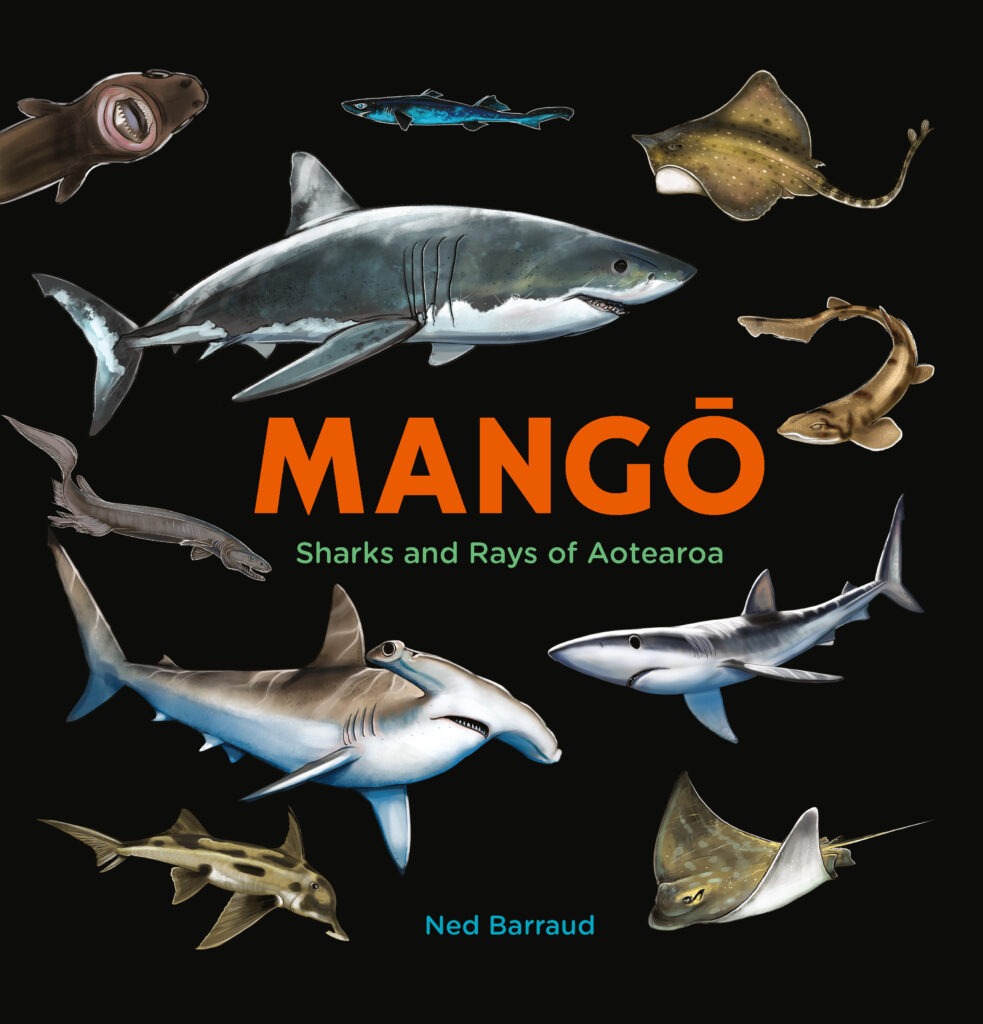
Rustle! Donovan Bixley’s Native Plants of Aotearoa, by Donovan Bixley (Little Moa)
In the same vein as Squawk!, there is now the plant version of Donovan Bixley’s venture into nature books. In his classic cartoon and humorous style, Donovan introduces readers to some of New Zealand’s best-loved flora. And I love how the titles of both books are based on sounds!
When I first opened the book I immediately loved the endpapers with leaves in shades of brown, and the contents page with each tree illustrated. The moa in the Little Moa logo on the title page warning readers not to pick or eat plants from the bush is a delightful little detail.
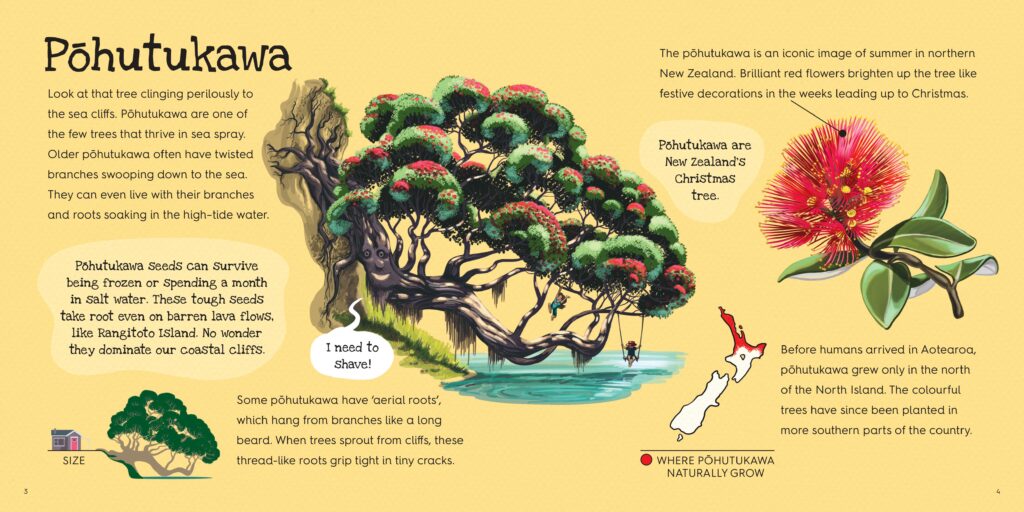
Each two-page spread features a different species, with information about the tree, whole-tree illustrations and detailed close-ups, and speech bubbles coming from people or other animals. There is a distribution map and a house for scale as well. The writing is pitched at a younger audience than the above three books, and with less text, making it accessible to both younger and older readers. The font size and spacing also allows for an easier reading experience. The middle of the book has a mountain and bush scene asking the reader how many native plants they can name in the image (I got 13, how about you?)
The only thing that gave me pause is that on the page about tī kōuka/cabbage tree, it’s mentioned that the tap root can be eaten, but not that extracting it kills the tree. It’s a small detail but I felt it would have been worth mentioning.
Overall it’s a lovely read and beautifully produced hardback (check out that spot gloss on the cover!) that is a great guide for young ones eager to learn more about Aotearoa’s native plants.
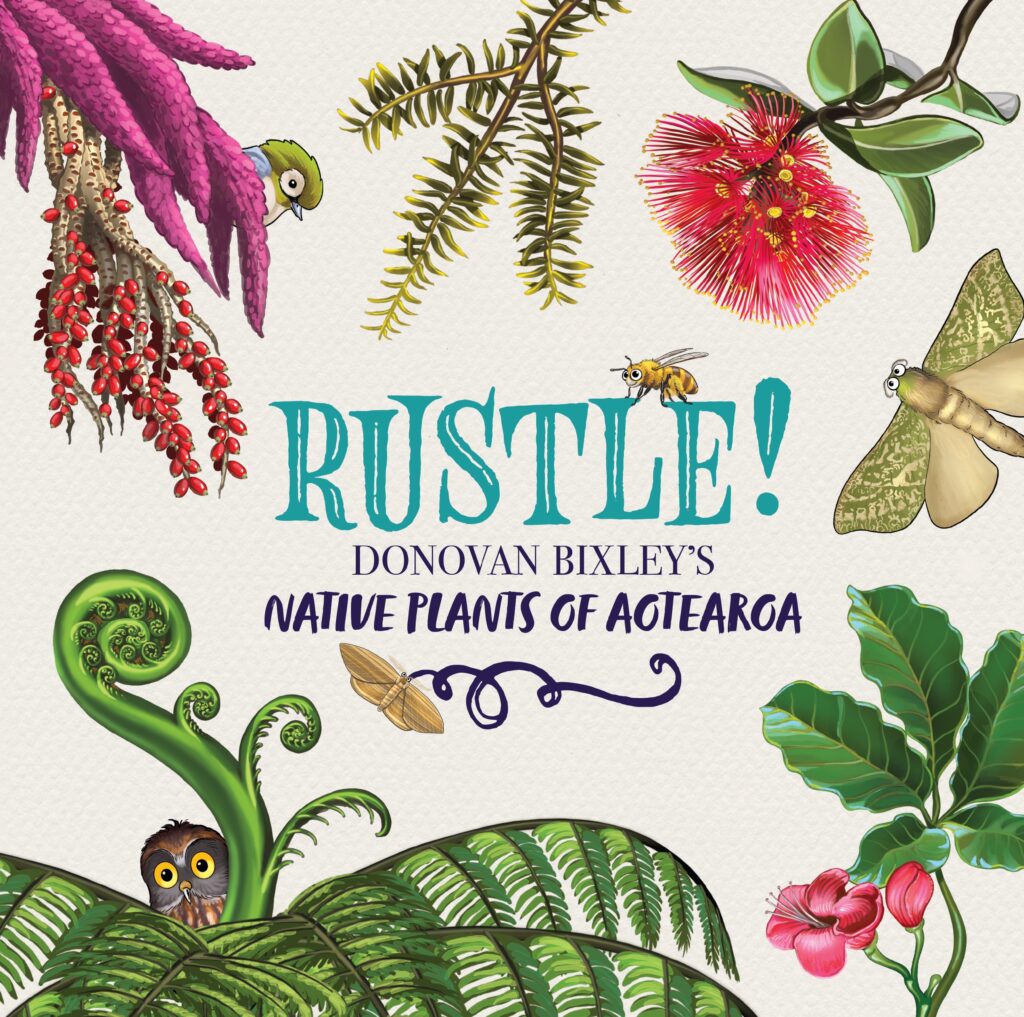
Rustle!: Donovan Bixley’s Native Plants of Aotearoa
By Donovan Bixley
Published by Hachette NZ
RRP: $24.99
Tuatara: A Living Treasure, by Katie Furze & Ned Barraud (Scholastic NZ)
Tuatara is an excellent picture book. It is the story of the life cycle of tuatara, told in beautifully descriptive language, lots of extra information about tuatara, and illustrated in wonderful detail by Ned Barraud. There is really nothing not to like about this book.
Tuatara is a perfect example of a creative non-fiction narrative well done. Written in prose, it’s a poetic read interspersed with fact boxes that don’t feel like interruptions. Its lyrical language, spacing between phrases, and way of asking and answering questions within the narrative make it a delight to read aloud. The illustrations work in harmony with the text and their earthy palette is a feast for the eyes.
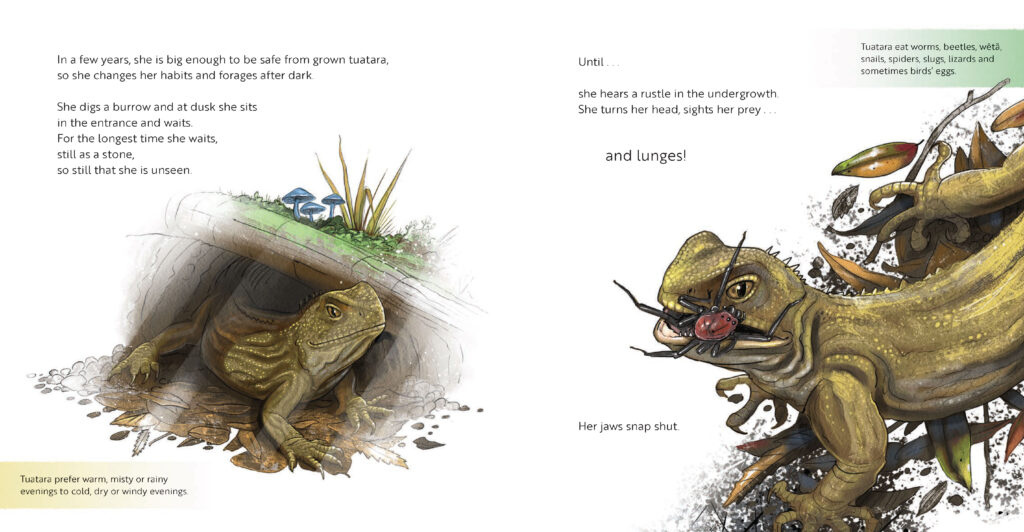
‘She’s too busy writhing,rolling, twisting and turning upwards through the soil.’
‘Will her eggs survive?
Maybe. Maybe not.’
‘Tuatara eggs don’t all hatch at the same time, and some don’t hatch at all. Nests of eggs are buried in the ground, and hatchlings take 8 – 9 hours to reach the surface.’
This is a great book for reading to younger audiences or for older children to read independently. I love seeing all the native wildlife books coming out of Aotearoa, and this is a superb addition.
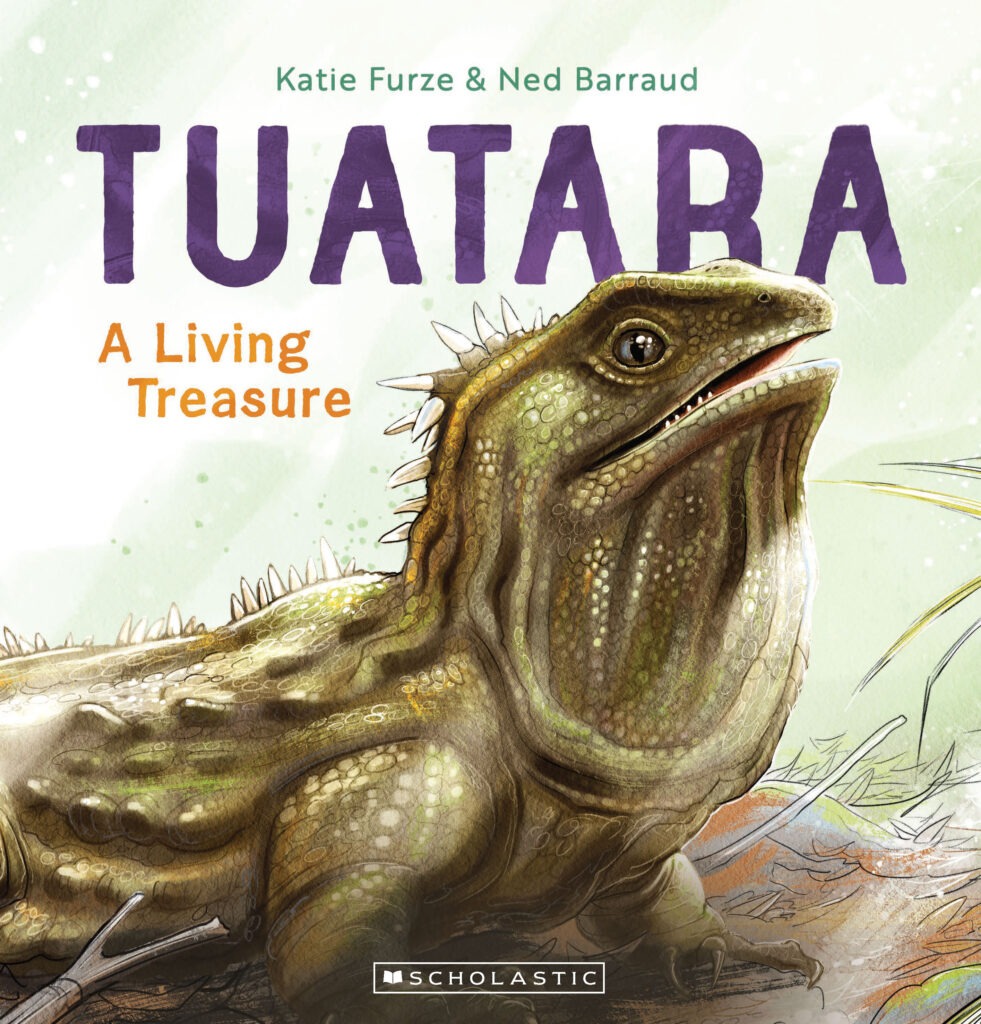
Tuatara: A Living Treasure
Written by Katie Furze
Illustrated by Ned Barraud
Published by Scholastic NZ
RRP: $21.99
The New Zealand Night Sky, by Alistair Hughes (White Cloud Books)
The New Zealand Night Sky opens with two lovely space-themed quotes and a very warm welcome to stargazing. It’s a great introduction to the night skies above Aotearoa, with sections on getting ready for viewing, explanations of celestial bodies, and constellation charts.
Each spread in the book looks like a fold out infographic you would find in a newspaper, which comes as no surprise given Alistair’s background in design. For me, this didn’t work as well in a picture book format, with bold white text on dark backgrounds a bit hard on the eyes. The pages work well as independent infographics but I found there wasn’t a feeling of narrative flow as you read through the book.
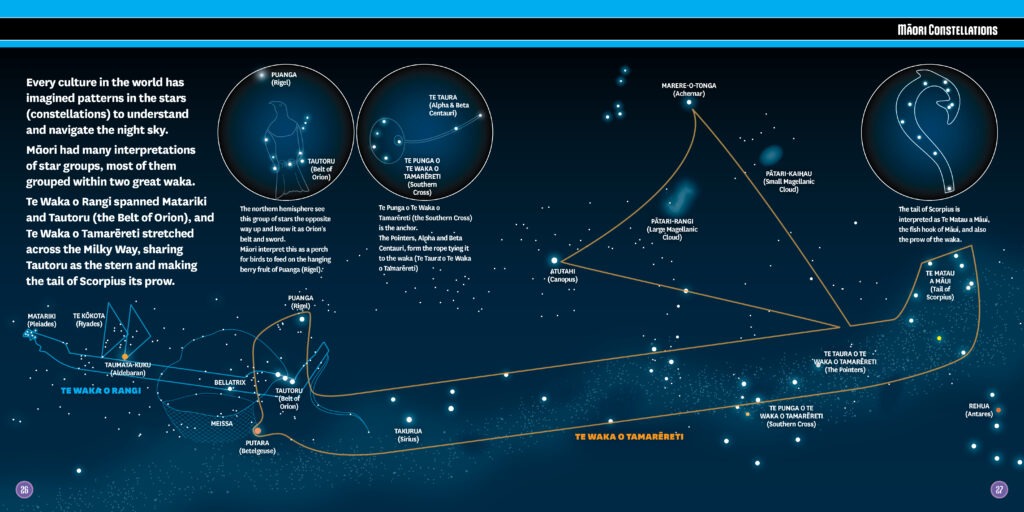
The information is well-written and divided into digestible chunks throughout the pages and there is certainly a lot to learn in this pukapuka. There is a mention of Captain Cook creating the “first maps” of Aotearoa but it would have been nice to differentiate them as physical maps, since early Māori would have had oral versions of the country’s geography. I was, however, pleased to see sections on Māori constellations and Matariki.
I also appreciated the inclusion of a section on New Zealand’s observatories, and the list of dates for upcoming partial and full lunar and solar eclipses (the next full solar eclipse visible in Aotearoa is in 2028! How cool!). The book creates a sense of wonder and invitation to the reader so makes a great night sky primer for kids (and adults!).
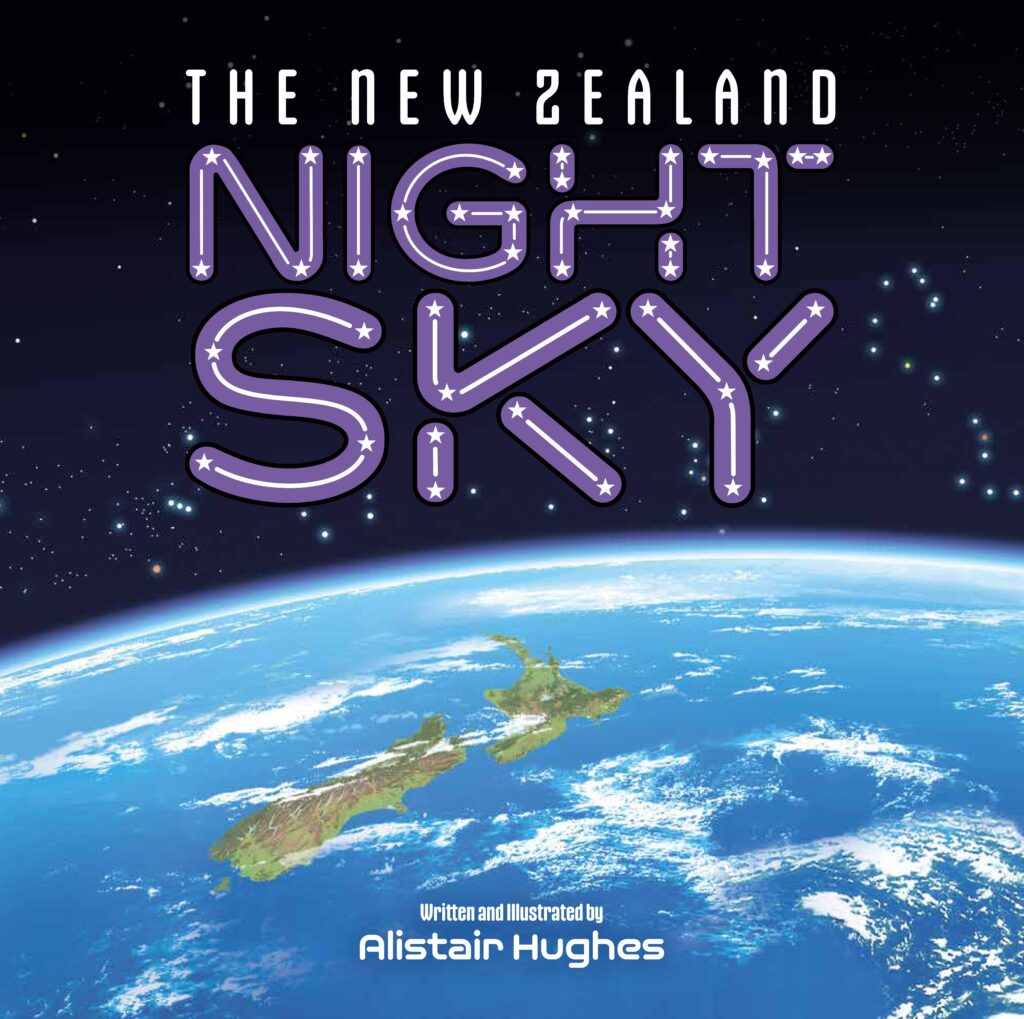

Linda Jane is a writer of picture books, poetry, essays and science. Her background is varied, including work in ecology, environmental education, summer camps, and a community newspaper. She is Singaporean-Pākehā, queer, and loves leaping into cold bodies of water. She was previously lead editor for The Sapling.



